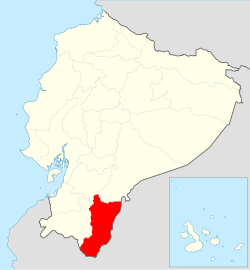
Ecuador is divided into 24 provinces. The provinces of Ecuador and their capitals are:
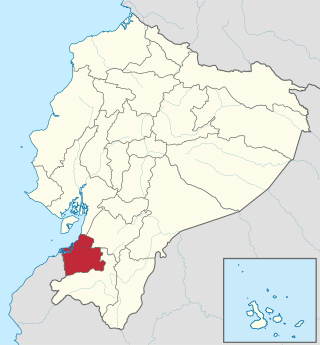
El Oro is the southernmost of Ecuador's coastal provinces. It was named for its historically important gold production. Today it is one of the world's major exporters of bananas. The capital is Machala.
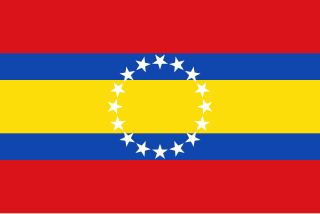
Loja Province is one of 24 provinces in Ecuador and shares its southern border on the west with El Oro Province, on the north with El Azuay, and on the east with Zamora-Chinchipe. Founded on its present site in 1548 by Captain Alonso de Mercadillo (Spanish), the site had been previously moved and rebuilt from La Toma due to earthquakes. It also is named as "Cuxibamba Valley", from the Quichua language, which means the "Smiley Valley".

Zamora Chinchipe, Province of Zamora Chinchipe is a province of the Republic of Ecuador, located at the southeastern end of the Amazon Basin, which shares borders with the Ecuadorian provinces of Azuay and Morona Santiago to the north, Loja and Azuay to the west, and with Peru to the east and south. The province comprises an area of approximately 10,559 km² and is covered with a uniquely mountainous topography which markedly distinguishes it from the surrounding Amazonian provinces. Zamora-Chinchipe is characterized and largely identified by its mining industry; indigenous ethnic groups with a rich archaeological legacy; its biodiversity; and its niche and tourist attractions, which include a number of waterfalls well-noted for their beauty. The province takes its name from the bureaucratic fusion of the Zamora and Chinchipe cantons. The provincial capital is the city of Zamora.
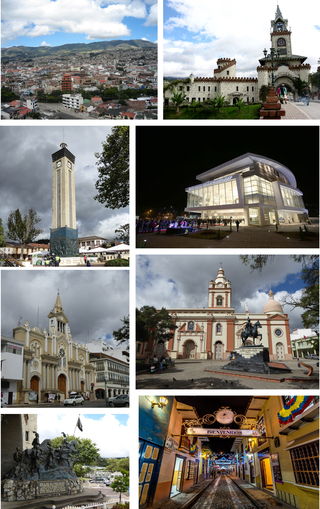
Loja, formerly Loxa and fully City of the Immaculate Conception of Loja, is the capital of Ecuador's Loja Province. It is located in the Cuxibamba valley in the south of the country, sharing borders with the provinces of Zamora-Chinchipe and other cantons of the province of Loja. Loja holds a rich tradition in the arts, and for this reason is known as the Music and Cultural Capital of Ecuador. The city is home to two major universities.

Zamora is a city in southeastern Ecuador; it is the capital of Zamora-Chinchipe province and the seat of Zamora Canton. Zamora is the principal and most populous city in Zamora-Chinchipe. It is located in the Oriente region ath base of the eastern portion of the Andes mountains in Ecuador, at 970 m above sea level, at the convergence of the Zamora, Bombuscaro and Jamboé rivers.

Loja Canton is located in the southeast of the Province of Loja bordering the Podocarpus National Park and the Province of Zamora-Chinchipe in the east and south, and the cantons of Saraguro in the north, Catamayo, Gonzanama, and Quilanga in the west. The principal city is Loja which is also the provincial capital. It is also home to Vilcabamba, the "Valley of Longevity."

Espíndola is a canton in the Province of Loja Ecuador. It is located in the south-east, bordered by the cantons of Quilanga and Calvas, the province of Zamora-Chinchipe and the country of Peru. It covers an area of 632 km2 at an altitude of 1720 m, with a population of 19,213. The average temperature is 19.9 °C.

The Zamora River is a tributary of the Santiago River located in the south-east of Ecuador. Historically, it was known to the Spanish as Yaya Mayu, from the river's name among a group of Shuar encountered nearby.
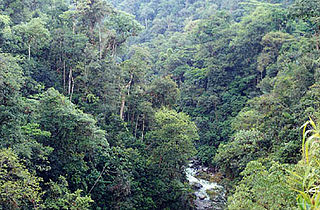
Podocarpus National Park is a national park located in the provinces of Zamora Chinchipe and Loja, in the south-east of Ecuador. It was created in 1982.

Yantzaza is a town in the Zamora Chinchipe province of Ecuador. It is the seat of the Yantzaza Canton.

El Pangui Canton is a canton of Ecuador, located in the Zamora-Chinchipe Province. Its capital is the town of El Pangui. Its population at the 2001 census was 7,441.

Palanda Canton is a canton of Ecuador, located in the Zamora-Chinchipe Province. Its capital is the town of Palanda. Its population at the 2001 census was 7,066.

Yantzaza Canton is a canton of Ecuador, located in the Zamora-Chinchipe Province. Its capital is the town of Yantzaza. Its population at the 2001 census was 14,552.

El Airo is a village located in the southern part of Ecuador's Loja province known for growing some of the best coffee in Ecuador. It is in the northwestern part of the Espindola canton about 25 km from Amaluza, the canton's capital.
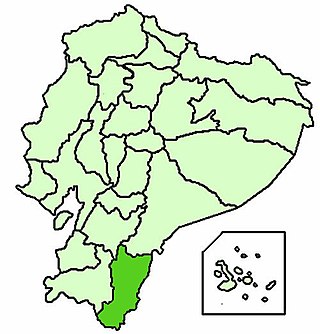
The Apostolic Vicariate of Zamora en [i.e. in] Ecuador is a missionary circonscription of the Roman Catholic Church.

Ecuador, officially the Republic of Ecuador, is a country in northwestern South America. The diversity of its four regions has resulted in hundreds of thousands of species of flora and fauna. It has about 1640 species of birds. The species of butterflies line the 4,500, the 345 reptiles, 358 amphibians and 258 mammals, among others. Ecuador is considered one of the 17 countries where the greatest biodiversity of the planet is concentrated. Most of its flora and fauna live in 26 areas protected by the State. It also offers historical attractions such as Quito, food, and a variety of cultures and traditions.

The Saraguro is a people of the Kichwa nation most of whom live in Saraguro Canton in the Loja Province of Ecuador. Although most now speak Spanish, Runashimi or Kichwa, a Quechua dialect, is also spoken and language revitalization efforts are being implemented. Likewise, the Saraguro have retained much of their land, customs and traditional dress. According to the INEC's 2010 population census, the total population of Saraguro canton is 30,183, but that total includes both the Indigenous and non-Indigenous people living in Saraguro.

Bracamoros is a region of numerous extinct tribal groups from the Ecuadorian and Peruvian Amazon rainforest, located in the watershed of the Zamora River.
